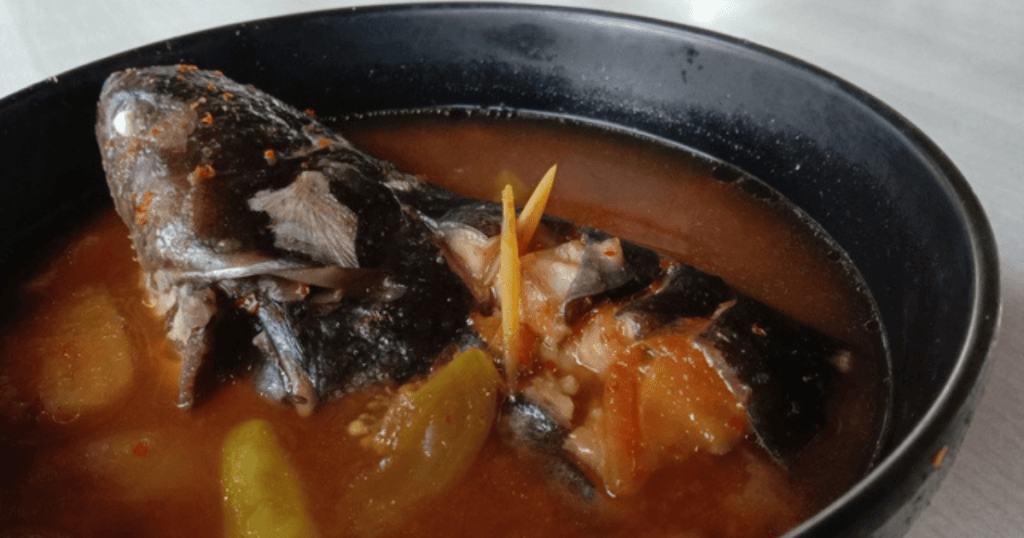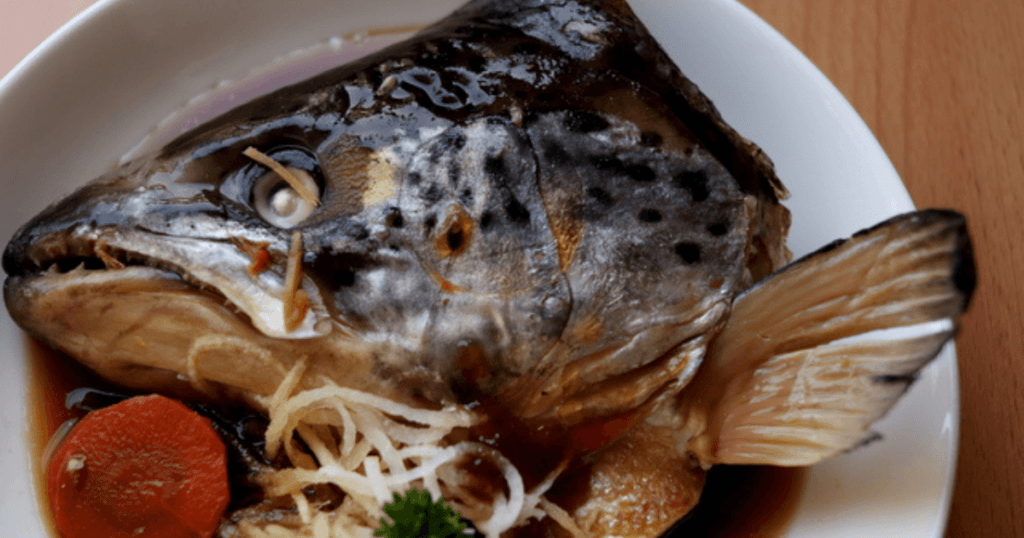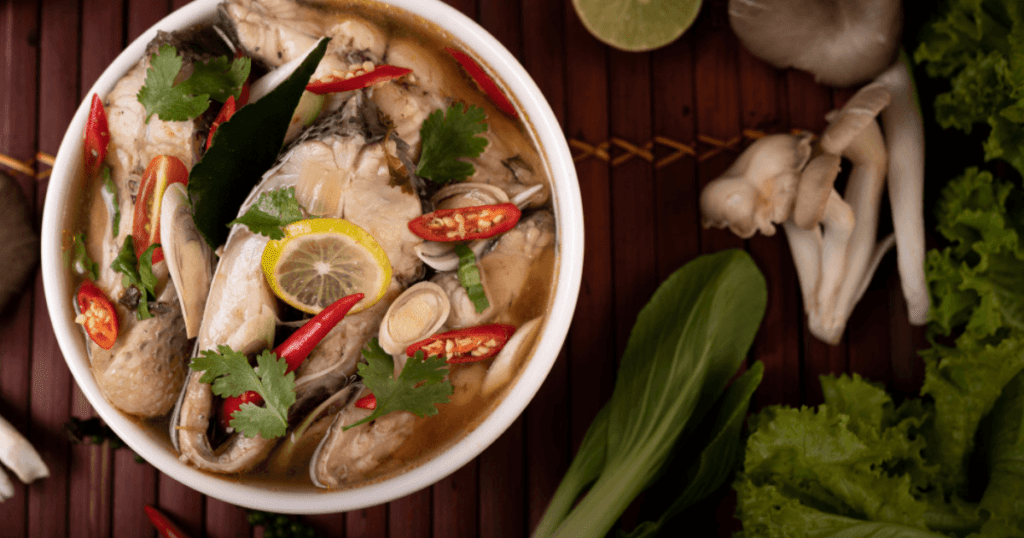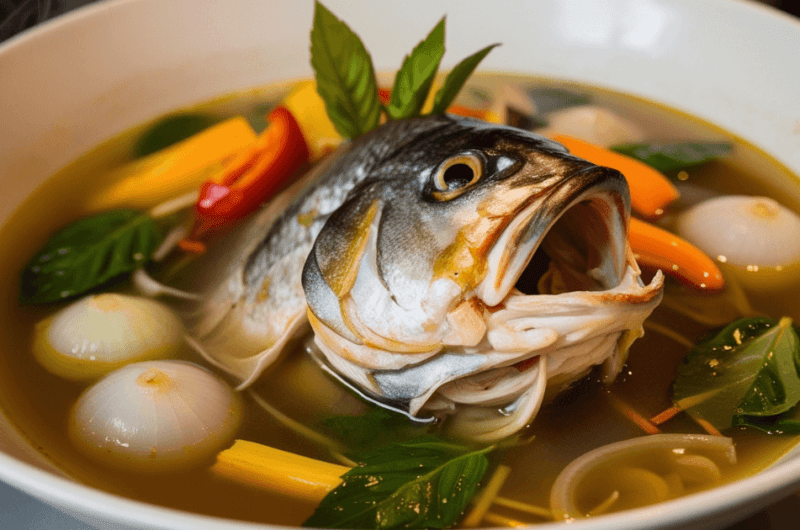Thai fish head soup recipe is a special Thai cuisine that reflects the culinary tradition of Thailand. The incredibly flavorful and aromatic dish has made it become an essential food in many Thai homes as well as restaurants. This cookery representative of fresh and balanced cooking in Thailand depends on such a simmered until tender fish head in a fragrant broth.
Thai fish head soup brings together delicate flavors of fish, infused with aromatic herbs and exotic spices, forming a harmonious symphony of tastes that delights the taste buds. It is an art to blend sweet, sour, salty and hot tastes into one meal which is typical of Thai cuisine. Each spoonful takes you through different flavors of Thailand; it shows how diverse its culinary expertise is.
When one explores the world around Thai fish head soup, one get more than just enjoying a tasty meal but also being immersed in culture. Therefore, by eating the Thai fish head soup we are accepting the fact that there is more to life than mere nutrition; And we have just joined millions all over the world who appreciate good food for what it really means.
Jump to RecipeIngredients for Thai Fish Head Soup

The authentic Thai fish head soup is created by using fresh and traditional Thai ingredients thus capturing the real taste of this timeless delicacy. Here is a breakdown of what it should contain:
The Broth:
- One large or two medium-sized fish heads like snapper or grouper to make the broth rich and flavorful.
- For the base of the broth, use about 8-10 cups of water.
- To spice up the broth with a citrusy flavor that is mildly spicy galangal: 2-3 thick slices.
- Add a slightly Citrus scent with Lemongrass (2-3).
- The Kaffir Lime Leaves: This is a Fresh Smelling Citrus Aroma for Your Soup
- Earthiness requires coriander roots (3-4)
- They will be juicy but not sour; this is because they are thinly sliced shallots (2.3).
- Garlic (3-4), which has been gently crushed in order to give it a mellow tangy taste.
- Slice these Thai Bird’s Eye Chilies lengthwise so they can add their characteristic heat in your food (2-3).
- -The signature taste of umami and salt in the broth is given by fish sauce: 2 – 3 tablespoons.
- -Tamarind paste for a little sourness and acidity – 1 to 2 teaspoons
Ginger for Thai Fish head soup recipe:
- Ginger Slices: 3-4 slices, to be used as complements to the inherent taste of the fish head.
- Tomatoes: A couple of large ripe tomatoes that are quartered for a touch of sweet and sourness.
- Onion: A medium-sized onion cut into rings to bring out a cool mild sweetness.
- Mushrooms: Some straw mushrooms or other kinds of them; these will give the dish an unusual flavor and texture.
- Cilantro: A big group of green coriander for decoration.
Why It Is Important to Use Fresh and Real Ingredients
To bring out the real taste of Thai food, as it shows the true nature of traditional Thai cooking, do not forget to use fresh herbs such as lemongrass, kaffir lime leaves, and galangal together with high quality fish sauce and tamarind paste in the preparation of an authentic Thai fish head soup. These ingredients are a must for one to get the original flavors found in Thai fish head soup which can never be obtained if they are absent. If used while still fresh, their strong smell and good flavor will make even those who don’t like spicy foods enjoy it by simply adding them.

Fish Head Preparation for Thai Fish Head Soup
Fish head cleaning and preparation is a vital part of making a tasty Thai dish that requires the fish head. This paper will give step by step instructions on how to clean and cook a fish head emphasizing on the importance of utilizing each bit of it to get its maximum flavor.
1. Cleaning the Fish Head:
- It is essential to start by rinsing off all spots using cold water in order to eliminate any dirt.
- Using a sharp knife, one can cut off the gills or excessive fins from that fish’s head.
2. Extracting Maximum Flavor:
- Cooking soup with whole fish heads which also include cheeks, eyeballs and collars which contain some tender meat but also some jelly-like parts that enrich soup with more flavors from them.
- The collagen-rich fish heads like cheeks and collar make the soup smooth thus enhancing its taste complexity.
3. Beheading the Fish:
- When a fish has a big head, it becomes possible to divide into smaller portions that are easily manageable in the course of cooking and which can be employed for extracting maximum flavor from all the parts.
- Cut the fish head precisely so as to help flavor infuse the stock while keeping its inherent richness intact.
4. How to handle Eyes and Cheeks:
- In some cultures, eyes and cheeks are highly esteemed delicacies; they are flavorful too; hence, they need to be used in soup.
- The areas around the eyes and cheeks contain gelatinous matter that provides this soup with a luxurious texture and an exceptional succulence.
5. Fish Head Storing:
- It is good to keep the cleared fish head in a refrigerator if it won’t be used immediately so as to remain fresh and have the best taste until when in use.
By paying attention to every detail of how the fish head is prepared, using even its eyes, cheeks and collar, Thai fish head soup comes out with a sublime flavor that is true to the Thai culinary tradition itself. Furthermore, with the gelatinous nature of fish heads, the soup gets this lavish savory taste which truly makes it outstanding.

Making the Flavorful Broth for Thai Fish Head Soup Recipe
It is crucial to produce an aromatic and tasty broth, which can make or mar Thai fish head soup. Described herein are the instructions of making a broth with infused aromatic herbs and spices; including the essential techniques of simmering the broth until it has become perfect.
1. Broth Infusion:
– Have galangal, lemongrass, kaffir lime leaves, coriander roots, shallots, garlic and Thai bird’s eye chilies into water in a big pot.
– Allow the combination of aromatics to gently boil over medium heat so that they may flavor the liquid creating a fragrant foundation for the soup.
2. SEASONING THE BROTH.
– Add some fish sauce and tamarind paste to the simmering broth, adjusting quantities precisely to make sure that umami, saltiness, and tanginess blend together harmoniously.
– It is important for a chef to taste the broth occasionally and correct its seasoning in order to have a balanced and flavorful base for the soup.
3. SIMMERING THE BROTH.
– After boiling let the heat go down until it simmers gently so that it could assume a deep flavor over time.
– While simmered slowly, this enables the infusion of liquid by herbs, spices, and fish head giving rise to an aromatic broth which is rich in Thai fish head soup.
– The prolonged simmering process brings out the flavors best from gelatinous components of fish heads thereby dissolving nutrients that contribute to its body and texture.
4. Assembling a Clarifying Broth:
– In order to obtain clear soup that is free from any impurities that come up during simmering, you can skim them off using a ladle.
– To have a thin broth without any remaining particles after the simmering process ended.
By following these detailed instructions and emphasizing the importance of slow simmering along with the art of seasoning, one can achieve a deeply flavorful and aromatic broth for the Thai fish head soup. These are secrets of making a rich soup that has an intricate taste profile like traditional Thai cuisine.
You may love to read the following recipe

Incorporating the Fish Head and Vegetables into the Broth
Once the fragrant soup is ready, next vital step is skillfully placing the fish head prepared and fresh vegetables in the brew. Here is a detailed practical guide that underscores cooking timing as well as technique required to perfectly cook fish head until it attains desired tenderness:
1. Adding the Fish Head:
– Gently immerse cooked fish’s head into boiling soup ensuring each part of it gets soaked in rich liquid.
– Slowly drop fish’s head inside liquid allowing it to be wrapped with flavor-filled herbs and spices.
2. Timing and Cook the Fish Head:
– During the process of boiling fish’s head in its own broth, do not forget about monitoring its condition, making sure that it does not become overdone so that it would still remain juicy with delicate texture.
– To maintain juiciness and taste of a well-cooked fish head still holding its form there should be proper timing for boiling this piece until tender surprisingly.
3. Introducing Fresh Vegetables:
– Put sliced ginger, quartered tomatoes, sliced onion and mushrooms in the broth once the fish head has reached its desired level of tenderness.
– The timing of vegetables addition is crucial because it allows imparting their flavors to the broth while keeping their colors and textures as they originally are.
4. Adjusting the Flavors:
– Let the fish head and veggies simmer together so that flavors blend well and vegetables soften slightly without losing freshness or vibrancy.
– Check for taste balance and adjust seasoning where necessary to attain a combination of tastes resulting from both fish head and fresh vegetables in a soup.
5. Ensuring Perfect Tenderness:
– Probe the fish head with a fork to test if it is tender enough, flaky yet firm to hold. Overcooking will make the fish head dry and less tasty; under cooking gives it an unpleasant tough texture.
These step-by-step guidelines and the importance of timing and observation as cooking proceeds will ensure that the fish head is cooked to a delectable tenderness while the fresh vegetables lend their vivid flavors and textures without losing their own characteristics. With this approach, the Thai fish head soup achieved is well balanced with taste being retained and out of nothing but respect for ingredients in sight.

Serving and Garnishing Thai Fish head soup recipe
If you are going to serve Thai fish head soup with fresh herbs and condiments, make sure it’s done in a way that enhances its flavors and complements its richness and complexity. Here are some tips that could help upgrade the presentation of the soup and improve its taste:
1. The Soup Presentation:
– The hot aromatic Thai fish head soup should be spooned into individual bowls; each portion must include plenty of broth, vegetables, as well as fish head.
2. Fresh Herb Garnish:
– Just before you serve the soup, sprinkle it with freshly chopped cilantro leaves. This will give your presentation a fresh and lively touch because of its vibrant green color and citrusy aroma.
3. Condiments and Accompaniments:
– Provide side steamed jasmine rice to accompany the soup for a heartier meal experience.
– For extra heat, finely slice Thai bird’s eye chilies into a small dish of fish sauce, each diner can regulate his or her own spice level.
4. Garnishing with Citrus:
–Right before eating squeeze a wedge of fresh lime over the soup; this acidic lime’s tang brightens up the flavors in the soup while harmonizing with its aromatic ingredients.
5. Traditional Complements:
– Include on your platter of fresh Thai herbs which may consist Thai basil, mint, sawtooth coriander as accompaniments to Thai fish head soup so that people have an option of adding more layers of herbal fragrance and complexity to their bowls.
– Additionally, slices of fresh red chilies can be offered for those who want to add some heat as per tradition.
If Thai fish head soup is served alongside traditional items with fresh herbs and condiments, this can make the dining experience better through a nuanced culinary journey that can be personalized to one’s taste in this particular dish. This thoughtful presentation also reflects the reverence for fresh, aromatic ingredients and the art of balancing flavors that are central to Thai gastronomy.

Nutritional Benefits of Thai Fish Head Soup
Traditional Thai fish head soup is good for health because it has high protein content and essential minerals that make it a wholesome dish:
1. High Protein Content:
– Fish heads are rich in proteins which provide the body with necessary amino acids for growth, repair and to remain healthy overall. Proteins are very important when it comes to muscle building, keeping them intact as well as metabolic functions.
2. Abundance of Minerals:
– When fish heads are boiled in the soup, they release essential elements such as calcium, phosphorous and magnesium into the liquid. These elements ensure that bones are strong enough, aid in muscles functioning and facilitate metabolism processes in general.
3. Low-Calorie Source of Nutrients:
– It is relatively low on calories; therefore, Thai fish head soup would be great for those who want to control their calorie intake but still have an enriching meal.
Health Benefits of Thai Fish head soup recipe
There are various health benefits for eating traditional Thai fish head soup because of its nutritional content and the use of fresh ingredients.
1. Bones:
– The inclusion of fish head, rich in minerals such as calcium and phosphorus, helps maintain good bone density, ensuring strong bones.
2. Proteins:
– Thai fish head soup is high in protein making it a vital part of a balanced diet that supports muscle growth, satiety, and overall nutrient balance.
3. Heart:
– Fish contained in this soup has omega-3 fatty acids which promote cardiovascular functions hence reduces one’s chances of acquiring heart diseases.
4. Nutrition:
– Fresh vegetables with aromatic herbs cooked with fish head make a nutritious soup that contains essential nutrients like vitamins, minerals, and antioxidants important for optimum health.
Thai fish head soup is rich in proteins and necessary minerals which can be obtained by anyone on healthy meals while enjoying numerous health benefits associated with this dish to enrich their cooking style.

FAQs-Thai Fish head soup recipe
What is fish head soup made of?
You can choose any fish head you like provided it is big enough to be worth your while, but then again if you like using the salmon heads, think about adding in dill and cream. Just sauté some onions or leaks, add the salmon heads and dill and if you prefer put in some potatoes or other vegetables.
Is eating fish head healthy?
Normally, fish heads are thrown away while only their bodies are taken for food. In reality, the head of a fish is far more nutritious than its body. Fish heads are an abundant source of several vitamins, minerals and healthy fats (and they are usually considered as one of the healthiest diets for your health).
What part of fish head is best?
According to Niland, the cheeks make a great starting point. From poaching them for a rich, thick stock to just roasting in the oven. It’s also a good idea to grill fish heads over charcoal due to their high collagen content which makes them smoke easily and hard to overcook.
Does fish head have collagen?
Our concentration shall be on collagen also known as gelatin when it comes to its edible form. Collagen is seen in animal bones and cartilage. In fish, it is found within the carcasses (including skeleton and heads).
Why is fish soup so good?
As fish are rich in several important nutrients, like high quality proteins, omega 3 fatty acids, it is advisable that a number (including pregnant women and young children) of various types of fish should be taken moderately. Moreover, fish soup can provide nutritional value such as omega-3 fatty acids.

Conclusion:
In a nutshell, Thai fish head soup is one of the most loved dishes with a cultural background and this comes from rich flavors and nutrients. Though it’s really just an old-style Thai dish that stresses the use of whole fish heads to obtain their best essence, it also combines fragrant herbs and spices in such a way as to produce an intense ambrosia. It has high levels of protein and minerals hence it has many health benefits like supporting bone health, intake of proteins, and heart health. This authentic recipe encourages us to discover the world of Thai cooking hence we can open our taste buds in appreciation of Thailand’s rich culinary heritage, as well as its vibrant tastes coupled with healthy eating for all on such a plate. As opposed to cohesion or coherence or other logical aspects, my spiritual experience has exposed me to the reality of life. So when one needs a nourishing meal or rather wants to enjoy various international cuisine styles Thai fish head soup provides an opportunity for you with the most memorable dinner ever.
Thai Fish head soup recipe
Course: SoupCuisine: ThaiDifficulty: Easy and Simple2
servings20
minutes40
minutes200
kcalIngredients
The Broth:
– One large or two medium-sized fish heads like snapper or grouper to make the broth rich and flavorful.
– For the base of the broth, use about 8-10 cups of water.
– To spice up the broth with a citrusy flavor that is mildly spicy galangal: 2-3 thick slices.
– Add a slightly Citrus scent with Lemongrass (2-3).
– The Kaffir Lime Leaves: This is a Fresh Smelling Citrus Aroma for Your Soup
– Earthiness requires coriander roots (3-4)
– They will be juicy but not sour; this is because they are thinly sliced shallots (2.3).
– Garlic (3-4), which has been gently crushed in order to give it a mellow tangy taste.
-Slice these Thai Bird’s Eye Chilies lengthwise so they can add their characteristic heat in your food (2-3).
-The signature taste of umami and salt in the broth is given by fish sauce: 2 – 3 tablespoons.
-Tamarind paste for a little sourness and acidity – 1 to 2 teaspoonsGinger for Soup:
– Ginger Slices: 3-4 slices, to be used as complements to the inherent taste of the fish head.
– Tomatoes: A couple of large ripe tomatoes that are quartered for a touch of sweet and sourness.
– Onion: A medium-sized onion cut into rings to bring out a cool mild sweetness.
– Mushrooms: Some straw mushrooms or other kinds of them; these will give the dish an unusual flavor and texture.
– Cilantro: A big group of green coriander for decoration.
Directions
- Cleaning the Fish Head:
– It is essential to start by rinsing off all spots using cold water in order to eliminate any dirt.
– Using a sharp knife, one can cut off the gills or excessive fins from that fish’s head. - Extracting Maximum Flavor:
– Cooking soup with whole fish heads which also include cheeks, eyeballs and collars which contain some tender meat but also some jelly-like parts that enrich soup with more flavors from them.
– The collagen-rich fish heads like cheeks and collar make the soup smooth thus enhancing its taste complexity. - Beheading the Fish:
– When a fish has a big head, it becomes possible to divide into smaller portions that are easily manageable in the course of cooking and which can be employed for extracting maximum flavor from all the parts.
– Cut the fish head precisely so as to help flavor infuse the stock while keeping its inherent richness intact. - How to handle Eyes and Cheeks:
– In some cultures, eyes and cheeks are highly esteemed delicacies; they are flavorful too; hence, they need to be used in soup.
– The areas around the eyes and cheeks contain gelatinous matter that provides this soup with a luxurious texture and an exceptional succulence. - Fish Head Storing:
-It is good to keep the cleared fish head in a refrigerator if it won’t be used immediately so as to remain fresh and have the best taste until when in use.

